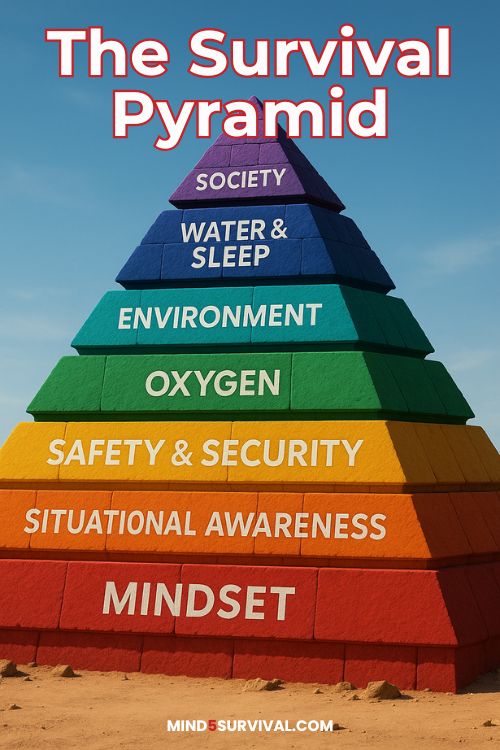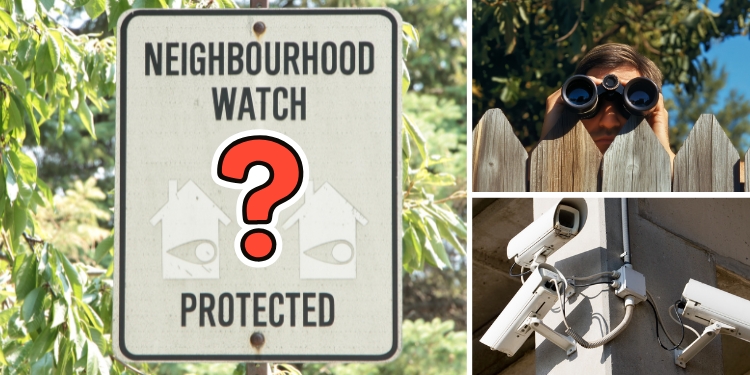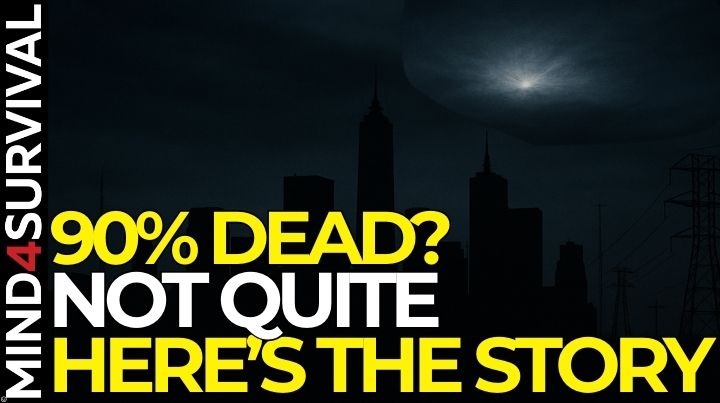The Survival Pyramid: What Actually Keeps You Alive

Podcast: Play in new window | Download
When disaster strikes, there’s no room for guesswork. That’s where the Survival Pyramid comes in. It strips things down to the essentials. It cuts through the noise and helps you focus on what actually keeps people alive—and what keeps them moving forward when everything else has gone sideways.
This is the framework I developed after decades of responding to emergencies—from lifeguarding and EMS calls to war zones, natural disasters, and real-world collapse scenarios. It’s built for people who want to have a solid framework from which to effectively prioritize their survival preparedness—without wasting time or money on the wrong things.
Let’s walk through it.
TL;DR: The Survival Pyramid shows what to prioritize in a crisis—mindset, action, oxygen, shelter, water, food, and community.
Quick Look at What You’ll Learn
Mindset: The Foundation You Either Build or Break On
Mindset isn’t about planning—it’s about attitude. Your attitude and approach to life are either your anchor or your downfall. Doesn’t matter how much gear you have, how many YouTube videos you’ve watched, or how many buckets of rice you’ve stored. If your mindset is weak, everything else becomes harder. A poor mindset sets a shaky foundation that can undermine even the best plans.
Mindset is what helps you stay calm when everything around you is chaos. It’s what sets you up to make smart choices under pressure, keep going when you’re exhausted, and pick yourself back up after a setback.
This isn’t about being fearless. It’s about learning to act in the face of overwhelm, fear, and uncertainty.
You don’t need to be a superhero. You just need to train your mind to separate yourself from the fight, flight, or freeze response that will impact you to some degree. That means learning how to:
- Slow down your thinking when your heart’s racing
- Put your emotions in check when needed
- Get comfortable with being uncomfortable
- Focus on the next step when overwhelmed.
That’s the base of the pyramid, because without it, everything else becomes less certain, harder to execute, and more likely to come up short.
Situational Awareness: One-Third of a Second
From the moment something happens—if it’s quick enough and bad enough—you may be lucky to have one-third of a second to start taking effective action.
This level is all about perception and recognition. What’s happening? Where’s the opportunity or threat? What’s different about this situation?
Your brain’s less likely to operate at peak performance if it’s not ready to understand what’s happening and take effective action. So train it. Make awareness a habit:
- Look for the best exits every time you walk into a building
- Play “what-if” games while you drive or shop
- Notice subtle shifts in body language, tone, and patterns
Awareness is the tool that gives you the earliest and best possible chance to take effective action. It’s good awareness that buys you options.
Safety and Security: Three Seconds
This level is about what you do when trouble shows up and there’s no time to think it through. It’s about response—real-world, gut-level, immediate action.
Safety is avoiding the problem altogether. Don’t be where the trouble is. Don’t take dumb risks. And don’t go looking for a fight you don’t have to have.
Security is what you do when avoidance fails. You have a threat that is currently or about to be a problem. This is the moment where you either act effectively—or you don’t.
You’ve got three seconds to do something meaningful:
Good practice, effective repetition, and being honest about your capabilities are what help you take meaningful action under pressure, rather than just reacting blindly.
If it’s not accessible—on your person, in your training, or in your awareness—it’s not useful in this moment.
This is the level where all that mindset and awareness training has to translate into action. Because the threat doesn’t care what you meant to do. It only cares what you actually do—and how fast you do it.
If you’re lucky, you’ll have three seconds to move, respond, and take effective action. That means this layer is all about fast, effective decision-making:
- Do you run?
- Do you fight?
- Do you speak up?
- Do you stay still?
This is where your prior training, habits, and experience take over.
- What’s your Everyday Carry (EDC)?
- What kind of clothing do you wear?
- Are you able to be mobile?
You may not have time to workshop a solution—whatever you do has to be as fast and effective as possible. That comes from preparation, not winging it.
Oxygen: Three Minutes
Without oxygen getting to your brain, the rest doesn’t matter. This level is literal: bleeding control, airway management, CPR, and protection from exposure to anything that blocks oxygen from reaching the lungs, brain, and organs must be dealt with immediately. If your brain isn’t getting oxygen, it’s lights out.
Your job here is to:
- Stop massive bleeding
- Open airways
- Keep blood flowing
- Use a mask or filter to keep toxins and oxygen blockers out of your lungs
Every second counts. Get trained. Know how to use a tourniquet and do CPR. Know how to clear a blocked airway. Have a protective mask available to filter out toxins or displacing gases. And carry the tools that make it possible—and keep them reachable. Not buried in your trunk.
🩸 Emergency Bleeding Control TrainingFor bleeding control training, check out StopTheBleed.org—it’s a trusted resource used nationwide.
Environment: Three Hours
Once you’re not actively trying to survive in the moment, your next biggest threat is exposure.
The rule of thumb is that you have approximately three hours in extreme weather before your body begins to shut down. Heat. Cold. Wet. Wind. It doesn’t take much. Truth be told, if you’re wet and it’s cold enough, you may have less than an hour to survive.
This layer is concerned with protection from environmental factors. Shelter. Fire. Shade. Animals and bugs. Being capable enough not to let Mother Nature win this round.
Do you have what you need to:
- Stay warm?
- Stay dry?
- Cool down?
- Avoid biting bugs and stinging plants?
This level also includes situational problems, such as finding yourself stuck in an unsafe location. It’s not just wilderness survival. It’s anywhere you’re vulnerable to the elements or other living things.
Water and Sleep: Three Days
Dehydration and exhaustion don’t just make you uncomfortable. They make you struggle, and the more you experience a lack of either, the more likely you are to have worse problems.
Your judgment slips. Your mood tanks. You make bad decisions. You feel ill. And then those bad decisions can start to snowball.
Three days without water and sleep, and you’re running on fumes. You’re not capable. You’re compromised. Difficulty taking action. Forced micro sleeps. None of that is good.
Prep now by:
- Stay hydrated
- Have a water PACE plan ready to go
- Building plans and routines that prioritize rest and recovery
Don’t treat sleep like a luxury. It’s part of the mission.
Nutrition: Three Weeks
You can live a surprisingly long time without food. But there’s a difference between living and functioning.
After a few days without proper calories, your body starts breaking down. Weakness, poor focus, low energy. In a crisis, that can be a death sentence.
That’s why nutrition matters. Not just long-term food storage, but:
- Balanced caloric intake
- Nutrient-dense meals
- Knowing how to cook and rotate your stores
- Planning for special needs
Don’t stockpile food you won’t eat or that causes you issues. Practice with what you store. Make food part of your everyday readiness. Have a food plan.
Society: Three Months
At the top of the pyramid is something that most survival checklists overlook: community.
Humans are social creatures. And after about three months without meaningful contact, most people begin to suffer physically and mentally. Isolation wears you down.
That’s why building a tribe is one of the most important things you can do. Your friends and family can all be part of your community. You define your community and decide who you want to let in, and who you want to keep out. A community should be based on values first, and skills second.
- Who’s got your back?
- Who can you help?
- Who do you trust when everything’s on the line?
Don’t wait for things to go bad to start building your circle. Start now. Strengthen it over time. Help others get ready, too.
The Bottom Line on the Survival Pyramid
The Survival Pyramid isn’t just a teaching tool. It’s a decision-making framework.
When life goes sideways, it gives you a clear path to follow:
- Where are you in the pyramid?
- What needs your attention right now?
- What can wait until later?
Use it to evaluate your gear. Your training. Your plans. Use it to check your decisions when things get hard. It’ll keep you focused on what matters most.
Because the truth is, people don’t always rise to the occasion. We fall to our level of preparation and worst decisions. And the Survival Pyramid is how we raise that level every day.
Additional Resources
Frequently Asked Questions
What is the Survival Pyramid?
It’s a framework that helps prioritize survival needs in order of urgency, from mindset to community.
How fast do I need to react in an emergency?
You may only have a split second to notice danger and about three seconds to act.
Where does water and food fit into the Survival Pyramid?
Water is critical within three days. Food becomes vital after about three weeks.
Why is community included in survival planning?
Support networks improve long-term survival, morale, and decision-making under stress.
📌 Next StepsLook at your own preparedness through the lens of the Survival Pyramid. What’s solid? What’s weak? Pick one layer—mindset, water, shelter, whatever—and tighten it up this week. Then post your focus in the comments. Someone else might need that same reminder.

Read the full article here









